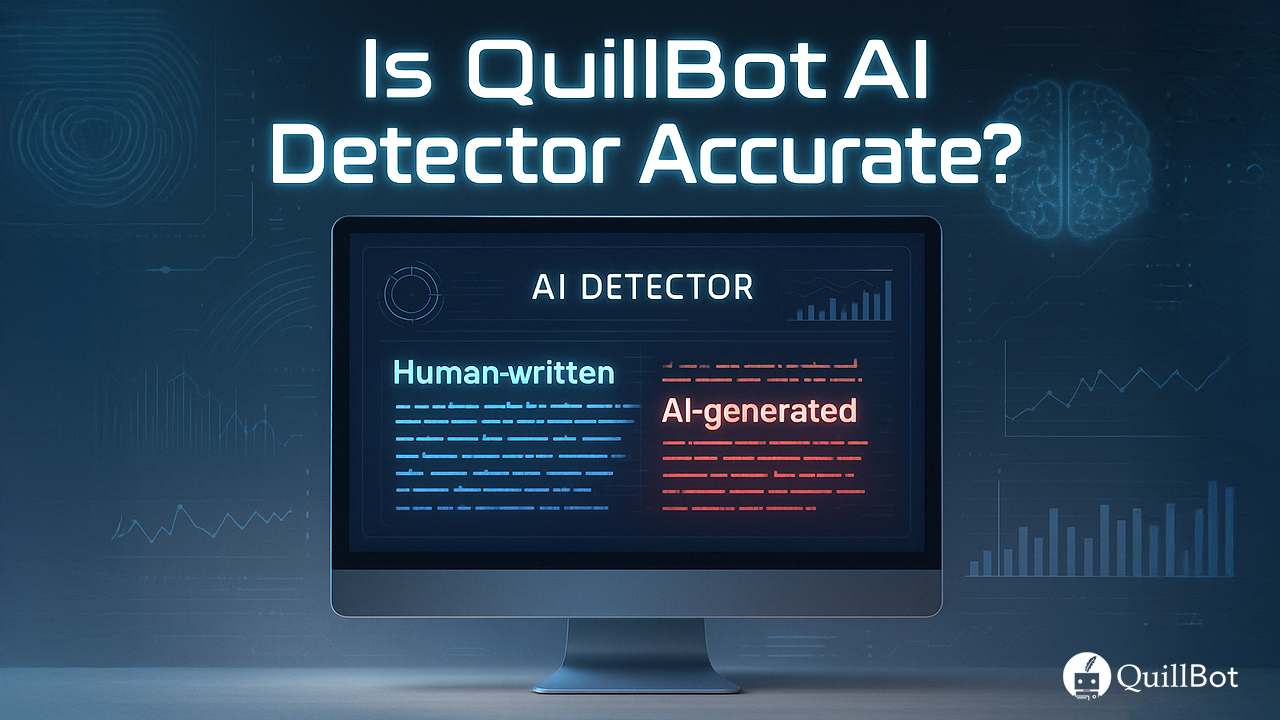In the advanced writing world, many AI-driven tools have significantly redefined how we approach content creation. But as students, teachers, and even professionals use these modern platforms, it’s becoming more important to understand the difference between human-written and AI-generated content. In space, there are also various AI detection tools, like the QuillBot AI detector that promises to effectively identify machine-generated content.
However, relying entirely on AI-detection tools is not reliable, as these platforms analyze text and deliver probabilistic outcomes rather than authoritative evaluations. This raises a critical question: is quillbot AI detector accurate enough to depend on for critical decisions?
Comprehending the trustworthiness of AI detection tools entails notable repercussions. Academic institutes depend on these platforms to maintain ethical standards, while content creators use them to check their content authenticity. This comprehensive blog explains the real performance insights of QuillBot through individual testing and highlights specific points where it fails or succeeds.
Understand What is QuillBot AI Detector
QuillBot is an online AI detection tool designed to scan text and ascertain the possibilities of AI involvement in it. The system works as a part of QuillBot’s extended writing assistance platforms, which typically include various built-in tools like a grammar checker, paraphrasing tool, and summarization tool.
The detector works by evaluating textual patterns instead of analyzing specific words or phrases. As users enter the content and click on Detect AI, the system instantly processes it through machine learning algorithms, which are often trained on large-scale datasets containing both human-written and machine-written samples. QuillBot then displays a statistical score, which indicates the probability that the text originated from AI-powered platforms.
Core Characteristics:
- Provide free detection of documents up to 1,200 words.
- Highlight sentences that have high possibilities of being AI-generated.
- Support diverse languages, including English, French, Spanish, German, and more.
- There is no need to log in or create an account for basic analysis.
- Classify content in three categories, including AI-generated, human-written, and human-written & AI refined.
The system mainly depends on two essential insights into its evaluation to access the content. First, perplexity indicates how expected common phrasing appears within a sentence. Lower perplexity rates analyse machine-created content, as AI-driven models usually choose common, guessable words. Meanwhile, burstiness determines fluctuation in sentence length, structure, and intriguingness within an entire document. Human-written content originally distinguishes greater burstiness due to variation in style, while AI-written content keeps things uniform.
Precision Performance Evaluation
External testing unlocks combined outcomes concerning whether QuillBot AI detector accurate analysis can be reliably trusted. Different research performed throughout 2024 and 2025 offers real performance metrics across diverse content types.
- GPTZero recently executed research and found QuillBot gains approximately 80% accuracy if it scans standard AI-generated content.
- BeLikeNative’s testing highlighted that the platform almost reached 100% precision in scanning unedited blogs created by ChatGPT. They also found that the performance dropped to 96% when the tool analyzes paraphrased AI content. Its accuracy also slowed down to just 60% when analyzing hybrid human-AI content.
- A recent PCWorld evaluation analyzes four common AI detection tools using the same AI-generated content. They found QuillBot detected 78% of the content as AI-generated, displaying strong consistency instead of full precision.
- In contrast, Originality.ai showed a 100% detection rate in the same testing conditions, presenting crucial performance inefficiencies among different platforms.
Evaluated Accuracy Rates Based on Content Categories
- Fully AI-generated content: High Accuracy typically between 92-98%
- Slightly refined AI content: Accuracy drops from 70-85%
- Heavily rephrased AI output: Rates falling to 60-75% accuracy
- Manually written academic papers: Sometimes flagged as AI generated 65-80% of the time—concerning false positive rates.
- Combined human-AI content: Hovers between 60-70% accuracy
Based on ZDNet's testing, it highlighted mainly concerning discrepancies. In one example, QuillBot detected fully human-written content as machine-generated with a 45% probability score. The tool then reported a 0% AI likelihood when researchers re-detected the same paragraph through the system later within the testing session. This variation creates a serious concern about trustworthiness.
An extensive 2025 content assessment detected QuillBot precisely analyzed 64% of AI-created content, while Turnitin and GPTZero consistently got above 93% accuracy. This significant performance gap emerges from thorough analytical rigor, as modern platforms identify semantic patterns and contextual connections to deliver meaningful insights.
Challenges and Real-World Applications
There are a wide range of elements that restrict whether is QuillBot AI detector accurate for large-scale implementations. Comprehending these limitations aids users in making data-driven decisions about whether trusting detection results is correct.
Key Limitations:
- False Positive Rate: One of the most significant challenges in QuillBot AI detection tool involves the tendency to incorrectly detect human-written content as AI-generated. Separate research insights show that it may be excessively optimized toward estimating the likelihood of AI content. This leads to baseless allegations against real human authors. For students creating educational content with structured language patterns, address this specific challenge.
- Performance with Advanced AI: Sophisticated language models like ChatGPT 5, Gemini Ultra, and Claude 3 now replicate human emotional expression and thought patterns more efficiently than previous versions. Its dependency on burstiness metrics and perplexity makes it less efficient as AI wiring technology advances increasingly.
- Struggles with Hybrid Content: Content combining human writing with AI refinement presents particular challenges. When writers draft original work but use AI tools for grammar correction or sentence restructuring, the detection system often cannot accurately differentiate between creation and editing.
- Editing Defeats Detection: Multiple tests confirm that moderate editing of AI-generated content successfully bypasses QuillBot's detection capabilities. Researchers who manually revised approximately 40% of ChatGPT output found QuillBot classified the edited version as human-written.
Practical Use Cases:
- Early Content Assessment: The platform functions well for instant initial verification of simple content. Businesses that function around a vast number of submissions can leverage it to detect clearly machine-generated content needing further monitoring.
- Institutional Awareness: Teachers can showcase the detection principle to students, helping them understand why keeping a genuine tone matters.
- Self-Assessment: Writers who are worried about whether their AI-assisted content has the necessary human quality can leverage QuillBot as one of the solutions to check their work authenticity.
Key Practices:
- Merging QuillBot with alternative detection tools like Originality.ai or GPTZero for cross-checking can be a great solution for precise results.
- Perform voice discussions about written content to examine real understanding.
- Identify context and rhetorical patterns across different samples from the same author.
- Implement human insights and skills rather than adopting automated outcomes unreservedly.
Conclusion
So, is QuillBot AI detector accurate? This extensive evaluation uncovers a platform that has real benefits but with few significant challenges. The platform gets 80-91% accuracy for simple AI-created content, setting it out as reasonably suitable for early-stage tracking needs. Yet, performance reduced significantly when detecting advanced, edited, or mixed content. The problematic false positive score, mainly affecting official academic papers, refers to an actual challenge when outcomes matter.
For conditions requiring greater dependency, such as academic credibility evaluations or professional determinations, QuillBot alone is not sufficient for all tasks. Alternative platforms, like GPTZero, Turnitin, and Originality.ai, show greater precision through extensive semantic analysis. Users addressing essential decisions should use diverse detection techniques, integrate manual monitoring processes, and avoid depending entirely on automated outcomes. Ultimately, QuillBot AI detector acts as the best component throughout a broader verification process instead of a definitive authority on content integrity.



